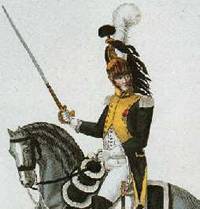 |
 |
 |
|
||||||||||
|
Napoleon
Bonaparte
|
|
| Career | Portraits |
| Quotes | Family |
| Loves | Letters |
| Plots | Murdered? |
| His will | Places |
|
Era
of Napoleon
|
|
| Powers | Opponents |
| Coalitions | Allies |
| People | Timelines |
| Key sites | Shrapnel |
|
Warfare
|
|
| Campaigns | Battles |
| Armies | Generals |
| Marshals | Winners |
| Glossary | Medical |
| Weapons | 1812 War |
| Uniforms | Battlefields |
|
War
at Sea
|
|
| Naval War | Heroes |
| Artworks | Signals |
| Nelson | Trafalgar |
|
Maps
|
|
| Key Maps | Peninsula |
| Animated | 1796/1800 |
| 1809 | Russia |
|
French
Revolution
|
|
| Revolution | Guillotine |
| Posters | People |
|
Art,
Film, Games
|
|
| Education | Goya |
| Sharpe | Hornblower |
| Books | Movies |
| DVDs | Music |
| Wargames | Images |
| Cartoons | Caricatures |
|
Other
|
|
| About Us | Sources |
| Awards | Sitemap |
| Links | Militaria |
| Miniatures | Reenactors |
| Forum | Quizzes |
| Home | Waterloo Diorama |
 Cuirassiers
were regarded as the decisive arm of the army by
Cuirassiers
were regarded as the decisive arm of the army by  France's
dragoons were the mainstay of the mounted arm of the
forces and were capable of either scouting, or being
involved in battle-winning charges.
France's
dragoons were the mainstay of the mounted arm of the
forces and were capable of either scouting, or being
involved in battle-winning charges. Hussars
were both the eyes and egos of the Napoleonic armies.
Hussars
were both the eyes and egos of the Napoleonic armies.
 Some
of the most feared cavalry in Bonaparte's armies were
the Polish lancers, who gave no quarter.
Some
of the most feared cavalry in Bonaparte's armies were
the Polish lancers, who gave no quarter.